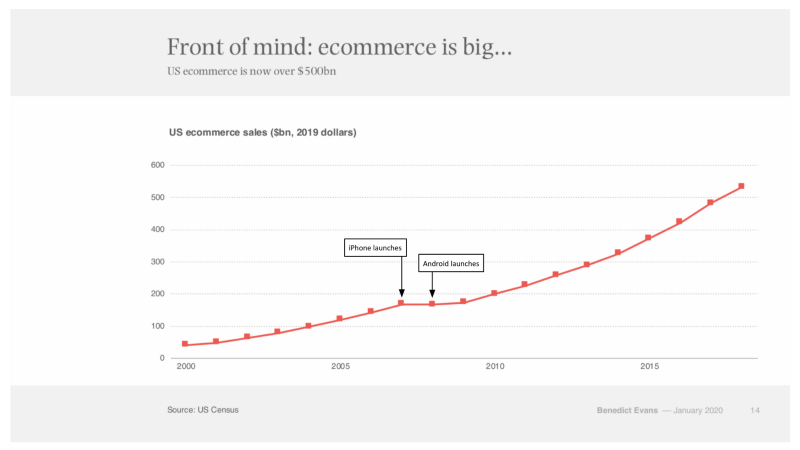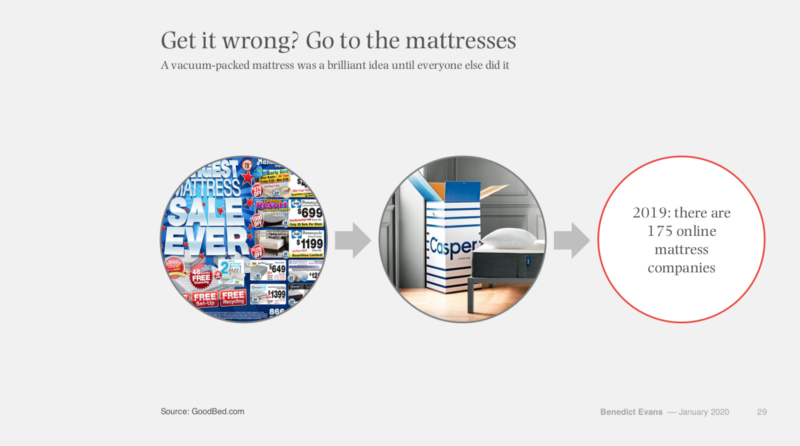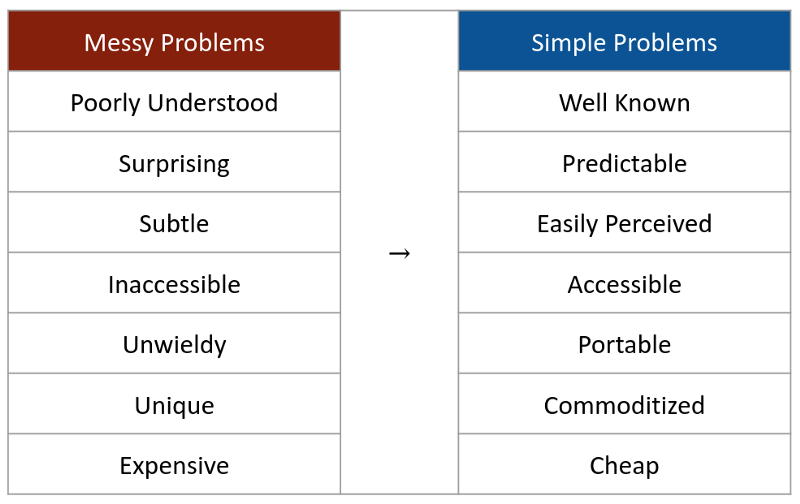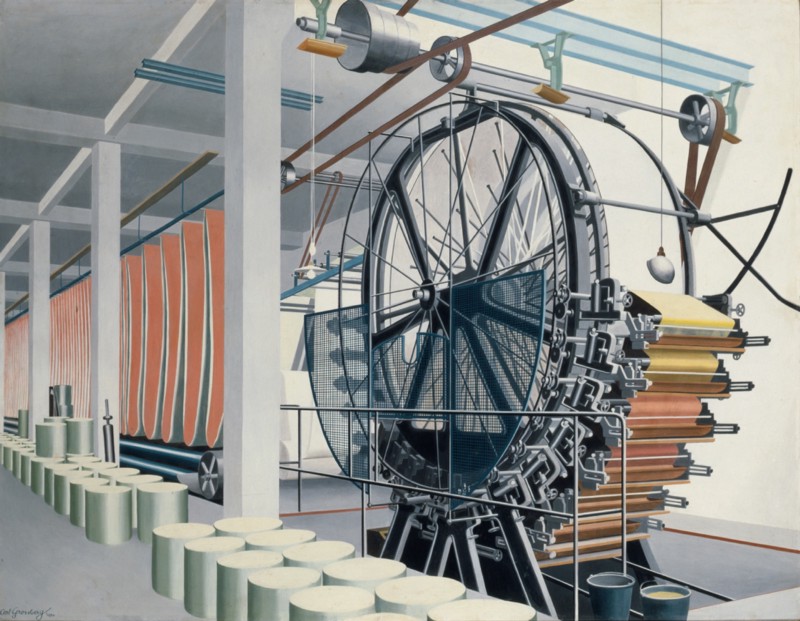What are We Waiting For?
Playing chicken with the limits of technology
Spend enough time thinking about the technology business and you’ll inevitably acquire a mental metaphor for the rhythms and cycles you observe. A specific book or presentation might snap into your head, providing scaffolding to order successes and failures you’ve observed over the years. Or — if you are prone to metaphors and storytelling — you might develop your own.
I fall firmly into the latter category. To me, a good framework for thinking about the technology business is asking, “What are we waiting for?”
In 2001 we were waiting for people. Today we’re waiting for robots. But hold that thought for a moment…
Benedict Evens recently published his annual presentation on macro trends within the technology industry. Please go read it first.
In the piece, Evens asks, “What happens when everyone is online?” then follows with a quote from Marc Andreessen:
Every failed idea from the dotcom bubble would work now.There are many reasons why the dotcom bubble burst, but a dominant one is not enough people were online soon enough. Companies, caught in a game of chicken, grew as if the masses were right around the corner. When they didn’t arrive (less than 10% of the population were online at the time) companies collapsed as their investments weren’t met by customers.
We were waiting for people, who didn’t arrive until smartphones matured because it turned out PC were too expensive and wonky for most. Once people arrived, things started picking up:

Slide from Benedict Evan’s deck. Ugly annotations by me.
We wait for the limits of technology to fall. Sometimes everyone waits for a accessible, sufficient mobile UI for the internet. Sometimes a sector waits for a new type of mattress that can fit in a cardboard box.
 ibid.
ibid.
Once a limitation is removed by an innovator, competition races to the new boundary. It’s a land rush. But if you’re investing in massive growth, you venture past the limit and hope it catches up before you run out of money.
The limits of technology can be shared headaches or niche enablers. But despite this diversity, they move in one direction on a spectrum from simple problems to messy problems:
 Messy problems are best solved by expensive human experts. They exist beyond the capabilities of technology. The job of new technology is to move problems from the messy column to the simple one.
Messy problems are best solved by expensive human experts. They exist beyond the capabilities of technology. The job of new technology is to move problems from the messy column to the simple one.
Some recent examples of messy problems made simple and the results:
- Smartphones made the internet accessible to billions, allowing eCommerce to grow.
- Vacuum-packed foam packaging made mattresses portable, allowing for direct-to-consumer mattress businesses to grow.
- High bandwidth connectivity made high definition video portable, allowing for streaming services to grow.
- High volume pricing for cellphone components made smart home devices cheap, allowing for our IoT Cambrian age.
- Modular shipping containers made small shipments portable and predictable, enabling the build out of global commerce. In my head I make a distinction between “what we’re waiting for” (the ends) and a limit of technology (the means). Many global consumer businesses were waiting for fast, cheap shipping — not the shipping container specifically.
So where are the current limits of technology? What’s preventing the next S Curves, as Ben Evens asks?
I keep a running list of problems that resist technology in an effort to spot patterns.
Sometimes the problems don’t make the headlines, like building parachutes:
Parachutes encounter turbulent and dynamic airflow, which is almost impossible to replicate with computers, said Erik Seedhouse, an assistant professor in spaceflight operations at Embry-Riddle Aeronautical University. Wind speeds vary at different altitudes. Atmospheric pressure changes in a hundredth of a second. The stresses on a parachute whose job is pulling out a larger parachute can be unpredictable.Parachutes are a poorly understood problem; their environment and performance cannot be modeled. It’s still messy.
Some of the problems that resist technology are comically mundane, like paper jams.
“Papers are not created equally,” John Viavattine, the head of the Torture Lab, said. Some stocks generate excessive friction; others swell in the humidity. (In general, winter jams are more common than summer jams.) Sheets cut from the same forty-ream roll can vary in quality. At the center of the roll, paper fibres tend to arrange themselves in an orderly matrix; nearer the edges, they become jumbled… Even the highest-quality paper can be ruined by poor “paper handling.” A half-used package of paper left to sit will grow damp and curly or dry and “tight.” Reams of paper that are thrown around or kept in stacks can develop hidden curls that lead to jams.Paper is surprising, unpredictable, so paper jams persist. Messy.
But the headline problems of our era are rooted in technology’s inability to perceive and understand. Software can read articles, organize photos, recognize faces, and spot pedestrians…but not with the skill required for massive rollout and acceptance. Software can perceive simple, predictable scenes, but it has yet to master truly messy perceptive problems. This limitation of technology is why we’re still waiting for robots, or AI.
Facebook and Google had hopes of solving moderation with AI. But the complexities of language and diversity of rule sets (Evens gets into this multicultural challenge elsewhere in his deck) resists present technologies. Companies must hire armies of moderators.
Uber can turn a profit with either complete market dominance or self-driving technology — a problem that remains messy because it’s surprising and subtle. AI, the hope goes, would address these limitations and enable >10x returns.
Companies that bet machine and deep learning would soon provide capable AI are in a squeeze right now. But they had little choice to not take a shot at AI, since any major advancement by a competitor could instantly provide their product at a fraction of their cost. (Uber details this dilemma quite well in their S-1.)
The dotcom companies of 2001 played chicken with the limits of technology and their competitors, building as if their world would arrive online tomorrow. But it took the greater part of a decade before people arrived.
Today, companies are waiting for robots, sacrificing researchers and capital, hoping they’ll arrive before the money runs out or the regulation arrives. So far the problem has resisted.
Which brings us back to Benedict Even’s question: “What is the next S-Curve?” I suggest the following questions as good discussions to have in pursuit of an answer:
- Where are the limitations of technology? What problems resist being directly addressed by software or hardware at scale?
- What are we — our current industry — waiting for? Where are we caught in games of chicken: where the rewards are so disrupting, the entire industry must invest in and chase the challenge?
- What is the advancement that has yet to arrive that we hope will put a stop to our waiting? What are the paths being explored and what are the paths less traveled?
- When the above advances arrive, what new use cases will they enable that we aren’t currently waiting for? (Note: as you can see above, the limitations of technology and what we’re waiting for are often not the same. And we often take a surprising route to arrive at our ends.)
- Poorly understood problems are the hardest technical limitations to solve. What limitations do we face today that are well understood? Poorly understood? I’m sure there are more (better!) questions to help think about the future. But thinking about what we’re waiting for has been fruitful for me, at the macro and micro level.
